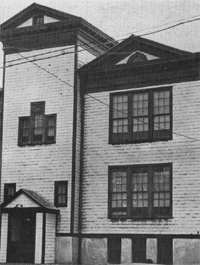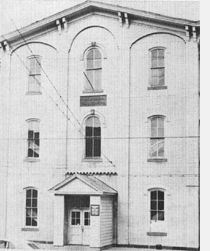





History of the School
It was on February 16, 1866, the first Board
of School Directors was elected. Prior to the
organization of this board, the schools were under the
direction and jurisdiction of West Mahanoy Township.
The first School Board of the borough was
organized May 15, 1866, and consisted of six directors,
who were: Nathan Longenberger, P. J. Ferguson, John
Tobin, J. P. Hoffman, Martin Scanlan, William Ploppert.
At that time the borough had but two wards—East and
West—Main Street being the dividing line.
Mr. Longenberger was the first president
of the board and Mr. Ferguson was the first secretary and
treasurer. Mr. Scanlan was collector of taxes at that
time.
The first Board, after its organization,
found itself surrounded with difficulties. The building that stood on the site of the
present structure at the corner of Lloyd and West
streets, was owned by the West Mahanoy Township School
District. When the Shenandoah independent district was
created, the township authorities closed the building and
refused to surrender possession unless they received
$2,000 for the property. The board refused to pay and a
lawsuit followed. Counsel was employed in the person of
John W. Ryan, Esq., but the case never came to trial. The
township agreed to settle for $500. Later the secretary
received an opinion from the State Superintendent to the
effect that the board could take possession of the
building and the township authorities could not
interfere. The settlement with the township had already
been effected and the matter was dropped. The first
school term was for nine months.
that stood on the site of the
present structure at the corner of Lloyd and West
streets, was owned by the West Mahanoy Township School
District. When the Shenandoah independent district was
created, the township authorities closed the building and
refused to surrender possession unless they received
$2,000 for the property. The board refused to pay and a
lawsuit followed. Counsel was employed in the person of
John W. Ryan, Esq., but the case never came to trial. The
township agreed to settle for $500. Later the secretary
received an opinion from the State Superintendent to the
effect that the board could take possession of the
building and the township authorities could not
interfere. The settlement with the township had already
been effected and the matter was dropped. The first
school term was for nine months.
On Dec. 3, 1870, the School Board
petitioned the Legislature for permission to issue
$15,000 of 8% bonds, and on April 10, 1871, purchased two
lots on the southwest corner of Centre and West Streets
for $1200.
In 1872 they decided to erect the
building on the site purchased, and on Feb. 18, 1873, the
building was opened and relieved crowded conditions of
the Lloyd Street school.
On July 2, 1874, the first
superintendent, Prof. G. W. Bartch, was elected for a
term of nine months at a salary of $1,000. Prof. Bartch
was re-elected April 20, 1875, for a term of three years,
at a salary of $1500 per year.
On Sept. 2, 1875, drawing was introduced
as a branch of study in the schools. On November 20,
1875, the superintendent was given power to examine,
promote, and make all necessary changes. The School Board
of 1876 was organized June 7, with an increased
membership, the borough having been divided into five
wards. On July 6, 1876, the board appointed the first
regular committees. Vocal music was introduced as a
branch of study, March 7, 1877. On April 3, 1879, the
board purchased two lots on North Main Street and decided
to build a high school. The contract was awarded to J. H.
Mears for $5,490. The building was equipped with steam
heat, water, gas and a stage for commencement exercises.
The first class graduated from the
Shenandoah High School in May 1879. The Shenandoah Public Library was established
on Jan. 15, 1880, and was used only by teachers as a
reference library. On March 31, 1881, it was thrown open
to the public for the first time.
Public Library was established
on Jan. 15, 1880, and was used only by teachers as a
reference library. On March 31, 1881, it was thrown open
to the public for the first time.
On May 4, 1884, Professor Bartch refused
to accept another term as superintendent of the public
schools and was succeeded by Prof. L. A. Freeman. May 6,
1885, the old brown schoolhouse on West Lloyd St. was
torn down and bids were received for the erection of a
two story twelve-room building on Lloyd St. At the same
time, another building was erected on Union Street. The
two buildings cost $13,500. They were completed Nov. 16,
1885. A part of the framework of the old brown
schoolhouse was used in constructing the Union St.
building.
The teachers for the term of 1885 were:
Wm. Cctther, Ray Fowler, Bridget Burns, Ida Koib, Annie
Roxby, Lizzie McKernan, Annie Dean, Ellen Golden, Minnie
Kimmel, Annie McGurl, Clara Cline, Annie Coogan, Mary
Wasley, Jenriie Goho, Annie Mansell, Elizct F. Finnerty,
Mary Lafferty, M. F. Albert, Amelia Schoener,Elizabeth
O'Connell, Annie Kimmel, Robena Glover, Maggie
Cavanaugh, Mary Wolley, Lizzie Lawbr, Estelle Kerm,
Mahala Fairchild, Anna Dengler, Laura Hoskins, Lydia
Eisenhower, W. N. Ehrhart, Principal.
The first public high school graduating
exercises were held in Ferguson's Opera House,
May 1, 1885. In January 1886 a school building in Turkey
Run was constructed. In 1888 the school board elected 44
teachers for that term and each succeeding year the
number of teachers was increased.
In 1890, an addition was built to the
Turkey Run schoolhouse. On Jan. 16, 1893, fire destroyed
part of the upper story of the high school building. The
cost of repairing the damage was $960, all covered by
insurance. May 2, 1893, Prof. M.P. Whitaker was elected
superintendent of the schools of the borough for three
years. At about this time it was decided to build a six
room building on West St. at the rear of the Centre St.
building which was done at a cost of about $16,000. In
1893 Mr. Ehrhart resigned the principalship of the High
School and Mr. J. W. Cooper was elected to succeed him.
Under the act of May 18, 1893, the School Board furnished
all textbooks and supplies to the pupils, free of charge
for the first time, and has continued doing so since.
In 1897 J. W. Cooper was elected
superintendent of the schools and was re-elected at the
close of every term until he died. He was succeeded in
1927 by Supt. A.J. Ratchford. There were 121 teachers in
1934; 41 in the high schools and 80 in the elementary
schools.
Aug. 19, 1927, A. I. Ratchford was
elected superintendent to continue to carry on the good
work of Supt. J.W. Cooper. Through the endeavors of Supt.
Ratchford, the Washington Grammar School was converted
into the present Jr. High School; Girls and Boys Bands in
the Cooper High School, Lincoln & Jefferson Schools
were organized; also a Fife Drum and Bugle Corps in the
grade schools was organized in a splendid manner. Field
days and Health Queen Pageants have occupied a prominent
place on the school calendar, as well as
Patron's Day when parents meet teachers and
work of the students is displayed and school problems
discussed.
Memorial Park is a tribute to the
foresight and energy of Supt. Ratchford who did much to
complete this recreational field for the children of
Shenandoah.
Following the retirement of Mr. Ratchford
in June 1951, Mr. Charles I. Stauffer was elected
superintendant. During five years of dedicated public
service to the schools of Shenandoah, Mr. Stauffer
re-organized the school curriculum to provide enriched
courses of study with emphasis on reading and library
development.
By forming a guidance department, he
helped hundreds of boys and girls to plan a successful
career. He broadened the guidance work by scheduling
biennial career conferences.
As part of a school improvement plan, Mr.
Stauffer directed the schools through a State Evaluation
and followed this successful examination with an
evaluation by the Commission on Secondary Schools, Middle
Atlantic States Association of Colleges and Secondary
Schools. As a result, the J.W. Cooper School received
an eminently satisfactory
evaluation and was placed on the list of
accredited high schools.
In June 1956, Mr. Stauffer resigned to
accept the position of supervising principal of the West
Reading Public Schools.
In the fall of 1956, Mr. Thomas Quigley,
assistant principal of the I. W. Cooper High School was
elected superintendent and served until 1958.
John J. Downey was elected superintendent
in 1958 and continues in this position at present time.
An excellent system of public and
parochial schools has been maintained in the borough.
There were ten public schools, the J.W. Cooper High
School, Junior High School, Jefferson School, Lincoln
School, the Old White St. School, which is now used as an
annex of the J.W. Cooper High School, Washington Street
School, Jardin St. School, Union Street School, Turkey
Run School and the Woodrow Wilson School. There are four
parochial schools: the Annunciation, St.
Casimir's, St. Stanislaus and the Holy Family.
A free public library and a commercial library are
available and well patronized.